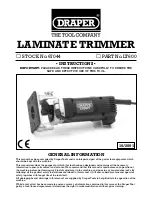
OPERATION MANUAL
6.2.2 Mounting large pictures on pre-coated
substrates
Required materials
■
A mounting board (a substrate coated with double sided adhe-
sive film)
Advice
Especially when mounting large pictures (starting from 1,50 x
3,00 m) it is difficult to mount the picture precisely onto the sub-
strate. The process explained below simplifies the handling of
large pictures and shows how to achieve optimal results even
with large pictures.
Sequence
1. Adjust the rollers approx. 5 mm bigger than the thickness of
the substrate.
2. Cut the picture according to the size of the substrate.
3. Lay the picture on the substrate and position it so that the
rollers are in the middle of the picture.
4. Align the picture with the substrate. Lower the top roller
with the hand wheel (3) so that the picture and the substrate
are fixed between the rollers
.
This will avoid the picture shift-
ing.
5. Drape the front part of the picture over the top roller (6).
ADVICE: If you work alone, weight the draped part of the
picture to prevent it turning back!
6. Peel off the cover paper from the mounting board and cut it
carefully on the level of the roller. Take care in keeping the cut
edge clean.
ATTENTION: Do not score or cut into the roller!
7. Take the weight off the picture, however continue to hold
back the picture with your hand.
8. Run the mounting board through the rollers and start with the
mounting process. At the same time release the picture
evenly and smooth out the picture from time to time along the
top roller (6).
9. Take out the half-mounted picture, turn it and run it
through the rollers up to the part that is already mounted.
10. Fix the mounting board and drape the front part of the picture
over the roller (6).
11. Peel off the cover paper from the mounting board.
Manual
Roll
Lam 120W;
Roll
Lam 140W;
Roll
Lam 160W 16






































